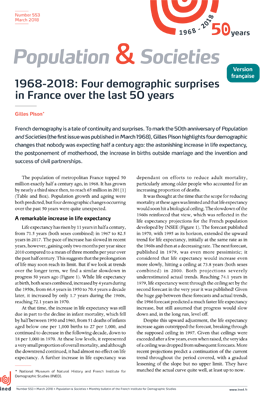1968-2018: Four demographic surprises in France over the last 50 years
Press release Published on 14 March 2018
Population & Societies no. 553 – March 2018

French demography is a tale of continuity and surprises. To mark the 50th anniversary of Population and Societies (the first issue was published in March 1968), Gilles Pison highlights four demographic changes that nobody was expecting half a century ago: the astonishing increase in life expectancy, the postponement of motherhood, the increase in births outside marriage and the invention and success of civil partnerships.
Life expectancy has risen by 11 years in half a century, from 71.5 years (both sexes combined) in 1967 to 82.5 years in 2017. Fifty years ago, no one imagined that such spectacular progress was possible, and the biological ceiling to life expectancy forecast in earlier projections has still not been reached.
Women in France today have as many children as their mothers (around two on average), but at later ages: mean age at childbearing has risen from 26.5 years in 1977 to 30.7 years in 2017. In 1977, women had their first child at age 24 on average, whereas today they start a family five years later.
Today, nearly 60% of children are born to unmarried parents, versus 6% half a century ago. Such births – rare and socially stigmatized – were officially designated as "illegitimate". But social norms have changed, and non-marital births are now more common than births to married parents.
The PACS civil partnership was introduced in 1999 partly with same-sex couples in mind, to enable them to register their union and enjoy the same rights as unmarried different-sex couples. To everyone’s surprise, the PACS soon became hugely popular with different-sex couples. Today, PACS registrations are almost as numerous as weddings, and 96% are between different-sex partners.
Author: Gilles Pison








